|
|
GIZE, STONEHENGE, CHICHEN ITZA, ETC,ETC: PIRAMIDES EN BOLIVIA (PIRAMIDES DE AKAPANA)-TIWANAKU-ETC-ETC
Elegir otro panel de mensajes |
|
|
|
BOLIVIA/BOLAS/SEXO MASCULINO/OLIVO/PALOMA DE NOE/COLUMBIA/PAZ. EL SEXO MASCULINO TIENE REFERENCIA A LOS DOS HUEVOS MITOLOGICOS QUE PONE LERA (CONSTELACION DEL CISNE), OSEA LA CRUZ DEL NORTE (FALICA) EN EL CONTEXTO A LA VIA LACTEA. JUSTAMENTE LA CRUCIFICCION/RESURRECCION DE NUESTRO SEÑOR SON UNA REFERENCIA A LA CONSTELACION DEL CISNE EN EL CONEXTO AL RENACIMIENTO DEL SOL EN EL SOLSTICIO DE INVIERNO EN EL HEMISFERIO NORTE. Ayer viendo el partido ARGENTINA-BOLIVIA, DIA MARTES QUE ES EL PLANETA ROJO Y FUERTEMENTE CONECTADO CON EL GRIAL, en el contexto al DOMINGO DE RAMOS (OLIVO) me preguntaba que me queria decir YHWH detras del mismo y observamos que todo tiene esa REFERENCIA. BOLIVIA ES SINONIMO DEL SANTO GRIAL AUNQUE USTED NO LO CREA. NOSOTROS como cristianos tenemos que mirar mas profundo que la longitud de nuestra nariz (VISTA DE AGUILA).
Proverbios 30:17: El ojo que escarnece a su padre
Y menosprecia la enseñanza de la madre,
Los cuervos de la cañada lo saquen,
Y lo devoren los hijos del águila.
17. Jeremías 49:22: He aquí que como águila subirá y volará, y extenderá sus alas contra Bosra; y el corazón de los valientes de Edom será en aquel día como el corazón de mujer en angustias.
NO ES CASUALIDAD QUE LA CAPITAL DE BOLIVIA ES LA PAZ.
OTRO DETALLE QUE OBSERVAMOS QUE BOLIVIA ESTA CRUZADO POR EL PARALELO 19.47 Y EN ESTE CONTEXTO TIENE NEXO CON LA "SEÑAL DE JONAS". SIMON PEDRO (HIJO DE JONAS) TIENE FUERTE RELACION CON EL GRIAL.
SEÑAL DE JONAS-¿PORQUE EL NEXO PEDRO CON JUAN MARCOS?
Consider the fact that the earth is a thin solid crust that is rotating at great speed around what is basically a liquid magma center. The result is an upwelling of great force that occurs at 19.47° North and South, that seemingly comes from nowhere. In any case the result is that a large amount of volcanic activity occurs at those latitudes. It is theorized that these forces are hyper-dimensional in nature and cascade into three-dimensional reality resulting in volcanoes.
Mauna Loa
|
Hawaii
|
19°, 28' N of equator |
Mauna Kea
|
Hawaii
|
19°, 36' N of equator |
| Mexico City |
Mexico |
19°, 23' N of equator |
| Dzibalchen |
Mexico
|
19°, 28' N of equator |
| Georgetown |
Grand Cayman |
19°, 18' N of equator |
| Mount Emi Koussi |
Chad |
19°, 47' N of equator |
| Mount Kalsubai |
India |
19°, 33' N of equator |
| Xiangkhoang |
Laos |
19°, 17' N of equator |
| Potosi |
Bolivia |
19°, 13' S of equator |
| Yasur, Tanna Island |
Vanuatu |
19°, 31' S of equator |
| Mount Samuel |
Australia |
19°, 13' S of equator |
| Gweru |
Zimbabwe |
19°, 31' S of equator |
Many of the sacred sites of ancient civilizations are also located at or very near to 19.47° North or South of the earth's equator including the Pyramid of the Sun at Teotihuacan, Mexico (19°, 36' N of equator).
19.47
ESTO EXPLICARIA EL NEXO SIMON (SEÑAL DE JONAS) CON EL NOMBRE DE BOLIVAR (SIMON). EL VERDADERO MENSAJE ES ESOTERICO.
Bolivia tiene fuerte nexo con el arca de Noe, insisto, en el contexto a la paloma con la rama de olivo y su referencia al septimo dia. Es un obvio nexo, BETANIA, PIE DEL MONTE DE LOS OLIVOS, FESTIVIDAD HEBREA DE OSHANAH RABBAH EL 21 DEL SEPTIMO MES HEBREO (LEVITICO 23:33), SIMBOLIZADA POR EL INGRESO DE CRISTO A JERUSALEM CON RAMAS DE OLIVO.
COMPARE CON AGEO 2
Hageo
2:1 En el mes séptimo, a los veintiún días del mes, vino palabra de Jehová por medio del profeta Hageo, diciendo: (21 DEL SEPTIMO MES/OSHANAH RABBAH/RITUAL DEL SEPTIMO DIA DE LA FIESTA DE LOS TABERNACULOS EN EL CONTEXTO A LAS RAMAS DE OLIVO/SEPTIMO DIA. El ungimiento de Betania tiene esta referencia)
2:2 Habla ahora a Zorobabel hijo de Salatiel, gobernador de Judá, y a Josué hijo de Josadac, sumo sacerdote, y al resto del pueblo, diciendo:
2:3 ¿Quién ha quedado entre vosotros que haya visto esta casa en su gloria primera, y cómo la veis ahora? ¿No es ella como nada delante de vuestros ojos?
2:4 Pues ahora, Zorobabel, esfuérzate, dice Jehová; esfuérzate también, Josué hijo de Josadac, sumo sacerdote; y cobrad ánimo, pueblo todo de la tierra, dice Jehová, y trabajad; porque yo estoy con vosotros, dice Jehová de los ejércitos.
2:5 Según el pacto que hice con vosotros cuando salisteis de Egipto, así mi Espíritu estará en medio de vosotros, no temáis.
2:6 Porque así dice Jehová de los ejércitos: De aquí a poco yo haré temblar los cielos y la tierra, el mar y la tierra seca;
2:7 y haré temblar a todas las naciones, y vendrá el Deseado de todas las naciones; y llenaré de gloria esta casa, ha dicho Jehová de los ejércitos. (La gloria tiene fuerte relacion con el septimo dia. ¿Hay un puente espiritual con la resurreccion de Lazaro?)
2:8 Mía es la plata, y mío es el oro, dice Jehová de los ejércitos.
2:9 La gloria postrera de esta casa será mayor que la primera, ha dicho Jehová de los ejércitos; y daré paz en este lugar, dice Jehová de los ejércitos.
|
RELACION DE MARIA MAGDALENA, LA PALOMA, EL OLIVO CON EL SEPTIMO DIA
1. Génesis 8:8: Envió también de sí una PALOMA, para ver si las aguas se habían retirado de sobre la faz de la tierra.
2. Génesis 8:9: Y no halló la PALOMA donde sentar la planta de su pie, y volvió a él al arca, porque las aguas estaban aún sobre la faz de toda la tierra. Entonces él extendió su mano, y tomándola, la hizo entrar consigo en el arca.
3. Génesis 8:10: Esperó aún otros siete días, y volvió a enviar la PALOMA fuera del arca.
4. Génesis 8:11: Y la PALOMA volvió a él a la hora de la tarde; y he aquí que traía una hoja de olivo en el pico; y entendió Noé que las aguas se habían retirado de sobre la tierra.
5. Génesis 8:12: Y esperó aún otros siete días, y envió la PALOMA, la cual no volvió ya más a él.
9. Cantares 1:15: He aquí que tú eres hermosa, amiga mía; He aquí eres bella; tus ojos son como PALOMAs.
10. Cantares 2:14: PALOMA mía, que estás en los agujeros de la peña, en lo escondido de escarpados parajes, Muéstrame tu rostro, hazme oír tu voz; Porque dulce es la voz tuya, y hermoso tu aspecto.
11. Cantares 4:1: He aquí que tú eres hermosa, amiga mía; he aquí que tú eres hermosa; Tus ojos entre tus guedejas como de PALOMA; Tus cabellos como manada de cabras Que se recuestan en las laderas de Galaad.
12. Cantares 5:2: Yo dormía, pero mi corazón velaba. Es la voz de mi amado que llama: Abreme, hermana mía, amiga mía, PALOMA mía, perfecta mía, Porque mi cabeza está llena de rocío, Mis cabellos de las gotas de la noche.
13. Cantares 5:12: Sus ojos, como PALOMAs junto a los arroyos de las aguas, Que se lavan con leche, y a la perfección colocados.
14. Cantares 6:9: Mas una es la PALOMA mía, la perfecta mía; Es la única de su madre, La escogida de la que la dio a luz. La vieron las doncellas, y la llamaron bienaventurada; Las reinas y las concubinas, y la alabaron.
|
|
|
|
|
|
|
Haz hecho público que te gusta. Deshacer
Haz hecho público que te gusta. Deshacer
www.youtube.com/watch?v=WPm13nzHW04
14/05/2008 - Subido por NationalGeographic
Pyramids PERU tours, Casma, America ancient city video, Mojeque. Ciudad .... AKAPANA the lost pyramid ...
www.youtube.com/watch?v=6GEXx8cIujY
15/06/2010 - Subido por MyPeruBoliviaTours
http://www.myperuboliviatours.com Tiwanaku is recognized by Andean scholars as one of the most important ...
www.ufo-contact.com/pumapunku
16/08/2011
Akapana Pyramid Bolivia Megalithic Tiwanaku 200x200 Pumapunku: Akapana ... Akapana Pyramid ...
Más videos de pyramid bolivia »
Haz hecho público que te gusta. Deshacer
Haz hecho público que te gusta. Deshacer
Haz hecho público que te gusta. Deshacer
Haz hecho público que te gusta. Deshacer
Haz hecho público que te gusta. Deshacer
|
|
|
|
|
|
Pyramids of Akapana, Bolivia
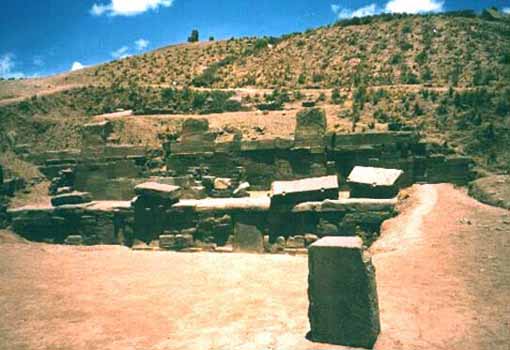
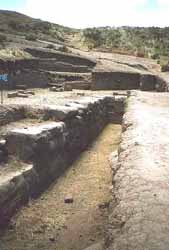
Drainage
The 59-foot-tall Akapana resembles a large natural hill more than a pyramid. Closer inspection shows walls and columns sticking out from the base and carved stones on its summit and tumbling down the sides. The somewhat amorphous shape of this tremendous pyramid is the result of centuries of looting and quarrying of its stones for colonial churches and even for a railway built in the 1900s. New research shows that this pyramid was never quite finished in antiquity.
At Tiwanaku we seem to have an interesting situation where the city's previous infrastructure was razed and completely redone just before the city was suddenly abandoned. It seems that around A.D. 700, three centuries into the existence of Tiwanaku as a monumental and powerful city, there was a sudden change to direct all construction efforts toward building what was the largest structure in the Andes. The previous monuments of the city were torn down and their stones reused to build the Akapana pyramid. The effort was too great, and the pyramid lay unfinished when the city was abandoned. One Spanish chronicler said of Tiwanaku, "They build their monuments as if their intent was never to finished them."
Around the rising pyramid, the arrangement of small single homes was replaced by large square compounds--also using the scavenged remains of previous monuments--serving perhaps as ritual places for powerful families or ethnic groups. What this change represents is unknown at the present. This could represent the rise of a powerful king, a popular religious movement, or the formation of a multicultural city. Whatever the cause behind this massive transformation, it didn't last long. By A.D. 950 all monumental construction suddenly ends with stones in various stages of dressing scattered around the partially built monuments.
The Akapana Pyramid Mound
In the News ...
Bolivian pyramid makeover disappoints MSNBC - October 19, 2009
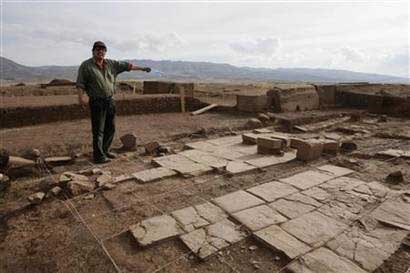
Tiwanaku, Bolivia - Eager to attract more tourists, the town of Tiwanaku in the Bolivian Andes has spruced-up the ancient Akapana pyramid with adobe instead of stone, in what some experts are calling a renovation fiasco. Now, the Akapana pyramid risks losing its designation as a U.N. World Heritage Site, and there is concern the makeover could even cause its collapse. P> The pyramid is one of the biggest pre-Columbian constructions in South America and a building of great spiritual significance for the Tiwanaku civilization, which spread throughout southwestern Bolivia and parts of neighboring Peru, Argentina and Chile from around 1500 B.C. to A.D. 1200.
Jose Luis Paz, who was appointed in June to assess damage at the site, says the state National Archeology Union, UNAR, erred in choosing to rebuild the pyramid using adobe, when it is clear to the naked eye that the original was built of stone. "They decided to go free-hand with the (new) design ... There are no studies showing that the walls really looked like this," Paz told Reuters as he stood before the pyramid in the Tiwanaku archeological site, some 40 miles north of Bolivia's administrative capital of La Paz. According to Paz, who now heads excavation at the site, the town of Tiwanaku hired the UNAR to renovate Akapana to make it "more attractive for tourists," regardless of how the pyramid may have originally looked like.
Thousands of tourists visit Tiwanaku every year and pay about $10 to enter the site, but the village of Tiwanaku, which manages the park, thought a better-looking pyramid would attract even more visitors, he said. Culture Minister Pablo Groux dismissed some of the criticism and said the renovation was long called for. "The UNAR has restored the original form the pyramid had. If we look at pictures from five years ago, there was just a hill there. What we can see now is something close to what the construction originally looked like," he told Reuters. Still, Paz said the controversy is not only about aesthetics.
The archeologist said lower decks are slightly tilted because of the extra weight of the adobe walls, which could lead to the collapse of the pyramid. The United Nations Educational, Scientific and Cultural Organization, or UNESCO, is due to visit Tiwanaku shortly and if it decides Akapana has been excessively tampered with, it may drop Tiwanaku from its list of World Heritage Sites. In 2000, UNESCO decided that Tiwanaku deserved to be in the list because its ruins "bear striking witness to the power of the empire that played a leading role in the development of the Andean pre-Hispanic civilization."
The Tiwanaku civilization, which flourished around Lake Titicaca, was one of the precursors of the Inca empire, the largest pre-Columbian civilization in the Americas. Groux believes that Tiwanaku will not lose its World Heritage status because the government halted the reconstruction project earlier this year, as soon as UNESCO told them to. "The inclusion in the list of World Heritage Sites involves regular checks, because some places may lose the essence of why they were included in the list. In the case of Tiwanaku losing that title is unlikely," he said.
Looting of Akapana's carved stones and ceramics started soon after the Spanish conquest and the structure was later used as a quarry, from which stones were extracted to build a rail line and a Catholic church near-by. Its size and the still-standing lower decks suggest that Akapana was once a remarkable building, but as a result of the ransacking and the extreme temperatures and strong winds in the Andean plateau, some 12,500 feet above sea level, the pyramid looks rundown.
Treasures found inside Bolivian Pyramid MSNBC - May 2, 2007
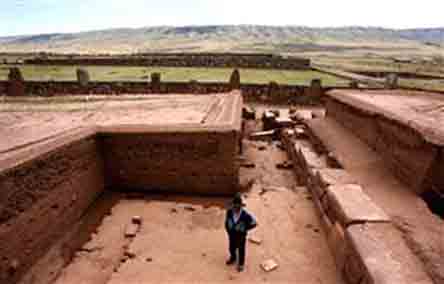
Archaeologists have uncovered the 1,300-year-old skeleton of a ruler or priest of the ancient Tiwanaku civilization, together with precious jewels inside a much-looted pyramid in western Bolivia. The bones are in very good condition and belong to either a ruler or a priest, Roger Angel Cossio, the Bolivian archaeologist who made the discovery, told Reuters on Wednesday. He said the tomb containing a diadem and a fist-sized carved pendant of solid gold survived centuries of looting by Spanish invaders and unscrupulous raiders who depleted Tiwanaku of many precious treasures.
"After so much looting ... miraculously this has stayed to tell us the history," Cossio said. "ItÕs a complete body... next to it are jewels, offerings and a llama." The llama may have been a status symbol or a source of food for the journey to the afterlife, archaeologists said. The corpse was found in a niche carved inside the 15-yard-high (15-meter-high) Akapana pyramid, which was built around 1200 B.C. and is described by experts as one of the biggest pre-Columbian constructions in South America. At its peak, the city of Tiwanaku stretched over 1,480 acres (600 hectares) and had a population of more than 100,000, according to chief archaeologist Javier Escalante, who presented the findings on Wednesday at a news conference near the pyramid.
The Tiwanaku civilization spread throughout southwestern Bolivia and parts of neighboring Peru, Argentina and Chile from around 1500 B.C. to A.D. 1200. Although experts still have to do carbon dating to determine the age of the remains, archaeologists estimate they were buried 1,300 years ago, during the decline of the Tiwanaku empire. Cossio believes the remains belong to someone of importance in the Tiwanaku society. "Not just anyone would be buried under the Akapana pyramid," he said. In the 1900s, workers used the base of the pyramid as a quarry from which they extracted stones to build a rail line connecting the neighboring town of Guaqui with La Paz.
INCA CIVILIZATION
ShareThis
PYRAMID INDEX
SACRED PLACES AND TEACHINGS INDEX
ANCIENT CIVILIZATIONS INDEX
ALPHABETICAL INDEX OF ALL FILES
|
|
|
|
|
EAGER to attract more tourists, the town of Tiwanaku in the Bolivian Andes has spruced up the ancient Akapana pyramid with adobe instead of stone, in what some experts are calling a renovation fiasco.
Now, the Akapana pyramid risks losing its designation as a UN World Heritage Site and there is concern the makeover could even cause its collapse.
The pyramid is one of the biggest pre-Columbian constructions in South America and a building of great spiritual significance for the Tiwanaku civilisation, which spread throughout south-western Bolivia and parts of neighboring Peru, Argentina and Chile from around 1500 BC to AD 1200.
Jose Luis Paz, who was appointed in June to assess damage at the site, said the state National Archaeology Union erred in choosing to rebuild the pyramid using adobe, when it was clear to the naked eye that the original was built of stone.

Tiwanaku ruins near La Paz in Bolivia
“They decided to go freehand with the (new) design,” he said.
“There are no studies showing that the walls really looked like this.”
The pyramid stands in the Tiwanaku archaeological site, some 64km north of Bolivia’s administrative capital of La Paz.
According to Mr Paz, who now heads excavation at the site, the town of Tiwanaku hired the UNAR to renovate Akapana to make it “more attractive for tourists”, regardless of how the pyramid may have originally looked like.
Thousands of tourists visit Tiwanaku every year and pay about $10 to enter the site, but the village of Tiwanaku, which manages the park, thought a better-looking pyramid would attract even more visitors, he said.
Culture Minister Pablo Groux dismissed some of the criticism and said the renovation was long called for.
“The UNAR has restored the original form the pyramid had. If we look at pictures from five years ago, there was just a hill there,” he said.
“What we can see now is something close to what the construction originally looked like.”
Still, Mr Paz said the controversy was not only about aesthetics.
The archaeologist said lower decks are slightly tilted because of the extra weight of the adobe walls, which could lead to the collapse of the pyramid.
UNESCO is due to visit Tiwanaku shortly and if it decides Akapana has been excessively tampered with, it may drop Tiwanaku from its list of World Heritage Sites.
In 2000, UNESCO decided that Tiwanaku deserved to be in the list because its ruins “bear striking witness to the power of the empire that played a leading role in the development of the Andean pre-Hispanic civilisation”.
The Tiwanaku civilisation, which flourished around Lake Titicaca, was one of the precursors of the Inca empire, the largest pre-Columbian civilisation in the Americas.
Mr Groux believes that Tiwanaku will not lose its World Heritage status because the Government halted the reconstruction project earlier this year, as soon as UNESCO told them to.
Looting of Akapana’s carved stones and ceramics started soon after the Spanish conquest and the structure was later used as a quarry, from which stones were extracted to build a rail line and a Catholic church nearby.
Its size and the still-standing lower decks suggest that Akapana was once a remarkable building, but as a result of the ransacking and the extreme temperatures and strong winds in the Andean plateau, some 3800m above sea level, the pyramid looks rundown.
Tags: Bolivia holiday, Bolivia tours, La Paz stopover tour, La Paz Tiwanku, la paz tours, Pyramids in Bolivia, Tiwanku ruins Bolivia, Tiwanku ruins tours
http://www.traveltosouthamerica.org/tag/pyramids-in-bolivia/
|
|
|
|
|
Ancient Bolivian pyramid 'could lose heritage status' after repairs
An ancient South American pyramid may lose its status as a UN World Heritage Site and even collapse after it was spruced up to "make it more attractive to tourists".
By Tom Leonard in New York
7:00AM BST 21 Oct 2009
In a makeover of the 59-ft high Akapana pyramid in Bolivia that an expert has described as archaeologically disastrous, the structure was rebuilt with abobe instead of the original stone.
The weight of the adobe – a mixture of sand, clay, water and sticks or straw – is now making the lower decks of the edifice tilt and could even cause it to collapse, said the architect in charge of excavations.
Jose Luis Paz, an archaeologist who was appointed in June to assess damage to the site, said the state National Archaeology Union, or UNAR, was hired by the local town of Tiwanaku to make the pyramid look more like a pyramid.
One of the largest structures in South America, it looks more like a large hill than a pyramid – a consequence, say experts, of centuries of looting, quarrying of its stone and wind erosion.
Mr Paz said the town, which manages the site, wanted the pyramid to be "more attractive to tourists".
"They decided to go freehand with the design. There are no studies showing that the walls really looked like this," Mr Paz said. It should have been clear from looking at the site that the original structure was made from stone, he added.
Worse, he warned that the lower decks were slightly tilted because of the extra weight of the adobe walls, which could lead to the pyramid's collapse.
Sitting on the shores of Lake Titicaca 40 miles north of La Paz, the Bolivian capital, the pyramid once formed the spiritual core of the Tiwanaku civilisation.
The city-state, which predated the Incas, spread through Bolivia and parts of Peru, Argentina and Chile between 1500BC and 1200AD.
The pyramid is believed to date from 300AD to 700AD.
The local town may have been goaded into giving the pyramid a makeover by international guide books, which have been complaining for some years that it is a rather unimpressive sight.
The site gets thousands of visitors a year, each paying an entry fee of $10 (£6).
Pablo Groux, the Bolivian culture minister, dismissed some of the criticism and said the renovation was long overdue.
"The UNAR has restored the original form the pyramid had. If we look at pictures from five years ago, there was just a hill there," he said.
"What we can see now is something close to what the construction originally looked like."
The United Nations Educational, Scientific and Cultural Organisation, or UNESCO, is due to visit Tiwanaku soon.
It could remove Akapana from its list of World Heritage Sites if it considers it has been excessively altered.
In 2000, UNESCO decided that Tiwanaku deserved to be on the list because its ruins "bear striking witness to the power of the empire that played a leading role in the development of the Andean pre-Hispanic civilisation".
|
|
|
|
|
-
Haz hecho público que te gusta. Deshacer
-
Haz hecho público que te gusta. Deshacer
-
Haz hecho público que te gusta. Deshacer
-
ww.losviajeros.net/fotos/america/bolivia/index.php?fn=tiwanako2En caché
Haz hecho público que te gusta. Deshacer
-
Haz hecho público que te gusta. Deshacer
-
www.losviajeros.com/pics/america/bolivia/index.php?lg=e&fn...En caché
Haz hecho público que te gusta. Deshacer
-
video.nationalgeographic.com/.../akapana-pyramid-te...
31/10/2011
Mystery of the Akapana Pyramid. Scientists decode the life-giving riddle of Bolivia's great Akapana pyramid ...
- Más videos de pyramid bolivia »
-
https://en.wikipedia.org/wiki/TiwanakuEn caché
Haz hecho público que te gusta. Deshacer
-
Haz hecho público que te gusta. Deshacer
-
Haz hecho público que te gusta. Deshacer
|
|
|
|
|
LA POSICION DEL SOL EN LA VIA LACTEA, EN EL CONTEXTO AL RIO NILO, ESTA DISEÑADA EN FUNCION A LA SEÑAL DE JONAS (ARCA PERDIDA/INDIANA JONES)
Here is an interesting read on Stargates and 19.47
In terms of Richard Hoagland's ' hyperdimensional physics' derived from the geometric 'message' of Cydonia (Mars), the conduit or 'stargate' between this world 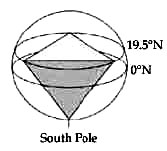 and the Otherworld (i.e. hyperspace) is prominently represented by the angle 19.5°. According to the theory, it is the tetrahedral geometry signified by this angle that enables inter-dimensional energy transfer between the two realms. and the Otherworld (i.e. hyperspace) is prominently represented by the angle 19.5°. According to the theory, it is the tetrahedral geometry signified by this angle that enables inter-dimensional energy transfer between the two realms.
 This 'stargate' geometry is expressed by a circumscribed tetrahedron (made up of four equilateral triangles). Interestingly enough, the hieroglyphic sign denoting Sirius was a triangle in ancient Egypt. This 'stargate' geometry is expressed by a circumscribed tetrahedron (made up of four equilateral triangles). Interestingly enough, the hieroglyphic sign denoting Sirius was a triangle in ancient Egypt.
The connection is made evident by archaeo-astronomy. First, it is widely accepted these days that the 'air shafts' inside the Great Pyramid were designed to aligned with certain stars. One was specifically targeted toward Sirius in c. 2350 BC.
And at that pinpointed time (c. 2350 BC), Sirius and Orion's Alnitak (representing the Great Pyramid as per the Orion Correlation Theory) together produced the angle 19.5° (when Sirius was rising on the Giza horizon).[10]
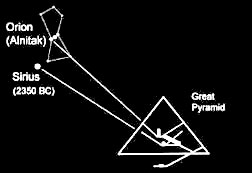 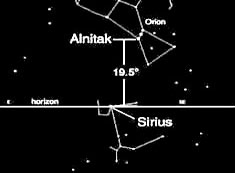
Next, it is natural - given the Sirius-Great Bend connection - to wonder about the possibility of the Nile's 'Winding Waterway' having some relevance to tetrahedral geometry. Indeed, we do find a clear connection!
Believe it or not, the northern peak of the Great Bend precisely pinpoints the tetrahedral/stargate latitude, 19.5°N.!

What's even more incredible is the fact that the same Bend peak also pinpoints 33°E longitude. As those familiar with Hoagland's work would surely know, '33' and '19.5' are considered the two key numbers in the 'hyperdimensional code'! (Hoagland is just not yet aware of this Nile connection.)
In 1997, the esoteric importance of those numbers was overtly demonstrated as NASA landed a tetrahedron-shaped Mars Pathfinder lander on the Red Planet at 19.5 N and 33 W.! (That's pretty in your face, isn't it?)


ORION – The Key To The Kingdom Of Heaven

TEXT TO FOLLOW

EL RIO NILO ES UN REFLEJO ESTELAR ADONDE OBSERVAMOS QUE LA CURVA DEL NILO A 33 ESTE Y 19.47 NORTE ESTA DISEÑADA EN FUNCION A LA SEÑAL DE JONAS. ¿QUE LE QUIERO DECIR CON ESTO? QUE LA POSICION DEL SOL EN LA VIA LACTEA, EN EL CONTEXTO AL RIO NILO, ESTA UBICADA EN FUNCION A LAS PROFECIAS DE CRISTO CON REFERENCIA AL GRIAL. EL ARCA PERDIDA ESPIRITUAL PERDIDO EN ETIOPIA QUE SABEMOS ES JUAN MARCOS. LA VERDADERA ARCA ESPIRITUAL PERDIDA ES EL HIJO DE MARIA LA MAGDALENA Y DE NUESTRO SEÑOR, QUE DESGRACIADAMENTE LA TRADICION PASO POR ALTO YA SEA POR ACCION O POR OMISION.
| phi in Simple Gematria Equals: 33 |
( |
p
16 |
h
8 |
i
9 |
) |
| ophir in Simple Gematria Equals: 66 |
( |
o
15 |
p
16 |
h
8 |
i
9 |
r
18 |
) |
66=33X2
JUAN MARCOS ES EL GRIAL
19+47=66=2X33
The time of the clock on back of the $100 dollar bill, As you can clearly see the time reads 2:22.
19.47 x 12.12 yrs = 235.9764 yrs = 235 yrs and 356 days
December 31, 1776 + 235 yrs and 356 days = December 21, 2012
19.47 x 12 yrs = 233.64 yrs = 233 yrs and 233 days
July 4, 1776 + 233 yrs and 233 days = February 22, 2010
.jpg)  
LA VIUDA PIDE JUSTICIA
Lucas
18:1 También les refirió Jesús una parábola sobre la necesidad de orar siempre, y no desmayar,
18:2 diciendo: Había en una ciudad un juez, que ni temía a Dios, ni respetaba a hombre.
18:3 Había también en aquella ciudad una viuda, la cual venía a él, diciendo: Hazme justicia de mi adversario.
18:4 Y él no quiso por algún tiempo; pero después de esto dijo dentro de sí: Aunque ni temo a Dios, ni tengo respeto a hombre,
18:5 sin embargo, porque esta viuda me es molesta, le haré justicia, no sea que viniendo de continuo, me agote la paciencia.
18:6 Y dijo el Señor: Oíd lo que dijo el juez injusto.
18:7 ¿Y acaso Dios no hará justicia a sus escogidos, que claman a él día y noche? ¿Se tardará en responderles?
18:8 Os digo que pronto les hará justicia. Pero cuando venga el Hijo del Hombre, ¿hallará fe en la tierra?
55. Mateo 23:14: ¡Ay de vosotros, escribas y fariseos, hipócritas! porque devoráis las casas de las VIUDAs, y como pretexto hacéis largas oraciones; por esto recibiréis mayor condenación.
56. Marcos 12:40: que devoran las casas de las VIUDAs, y por pretexto hacen largas oraciones. Estos recibirán mayor condenación.
65. Lucas 20:47: que devoran las casas de las VIUDAs, y por pretexto hacen largas oraciones; éstos recibirán mayor condenación.
¿"Devoran la casas de las viudas" no es una alusion a que devoran la casa/linaje de la viuda? ¿Porque Jesucristo incluso relaciona la viuda con JUAN MARCOS en Hechos 12:12?
1. Hechos 12:12: Y habiendo considerado esto, llegó a casa de María la madre de Juan, el que tenía por sobrenombre MARCOS, donde muchos estaban reunidos orando.
Es obvio que MARIA LA MADRE DE JUAN ES LA VIUDA.
¿PORQUE SE RELACIONA LA VIUDA CON LA EXPULSION DE LOS MERCADERES DEL TEMPLO? ¿HAY UNA CONSPIRACION CONTRA LA VIUDA? ¿QUE PIENSA USTED?
1. Isaías 56:7: yo los llevaré a mi santo monte, y los recrearé en mi casa de oración; sus holocaustos y sus sacrificios serán aceptos sobre mi altar; porque mi casa será llamada casa de oración para todos los pueblos.
2. Mateo 21:13: y les dijo: Escrito está: Mi casa, casa de oración será llamada; mas vosotros la habéis hecho cueva de ladrones.
3. Marcos 11:17: Y les enseñaba, diciendo: ¿No está escrito: Mi casa será llamada casa de oración para todas las naciones? Mas vosotros la habéis hecho cueva de ladrones.
4. Lucas 19:46: diciéndoles: Escrito está: Mi casa es casa de oración; mas vosotros la habéis hecho cueva de ladrones.
6 DE AGOSTO / BOMBA DE HIROSHIMA / SALIDA HELIACA DE SIRIO / INDEPENDENCIA DE BOLIVIA / PARALELO 19:47 / TRANSFIGURACION DE JESUS (IGLESIA CATOLICA)
19.47
|
|
|
|
|
hartosdeesto.blogspot.com/.../puma-punku-la-ingenieria-de-los-dioses.ht...
02/04/2013 - PUMA PUNKU, LA INGENIERIA DE LOS DIOSES. ... adjetivo , es el asentamiento megalitico de Puma punku, en Bolivia , dentro de las ruinas ...
www.youtube.com/watch?v=Vno90_Qu9Bo
27/11/2012 - Subido por cristoverdu
Con cerca de 14.000 años de antigüedad, la ruinas de Puma Punku son las ... Una serie de investigadores se ...
www.youtube.com/watch?v=XiASBVHpPhg
22/03/2012 - Subido por Manu Rivers
Con casi 14.000 años de antigüedad, las ruinas de Puma Punku son las ... Isla de Pascua, Tiahuanaco ...
www.youtube.com/watch?v=Y_lyaKBQkog
09/07/2013 - Subido por TodoEnigmas
Cada vez hay más personas en el mundo que creen que civilizaciones no terrestres nos visitaron en el pasado ...
www.pacal.de/pumapunku_es.html
A 4000m de altitud, sobre el altiplano en Bolivia, se encuentra ... a unos 100 metros: Las ruinas de Puma Puncu. ... Información detallada sobre Puma Punku ?
www.boliviaweb.com/tours/tourdetails.aspx?TourId=47&lang=es...
Spanish. Ruinas de Tiwanaku (16/19), Ver al Autor | Contactar al Autor. Primera | Anterior | Siguiente | Ultima. RUINAS DE PUMA PUNKU. Pirámide de grandes ...
|
|
|
|
|
martes, 2 de abril de 2013
PUMA PUNKU, LA INGENIERIA DE LOS DIOSES...¿ Realmente lo eran?.
 |
| Los grados de precision en el corte son descomunales |
Dentro de los lugares de origenes , mucho más que dudosos, los cuales , no creo tener que nombrar siquiera los mas conocidos, creo que si algun lugar merece absolutamente ese adjetivo , es el asentamiento megalitico de Puma punku, en Bolivia , dentro de las ruinas de Tihuanaco, a más de 3500 metros de altitud y más de 14.000 años de antigüedad le dan el poder de , tal vez la número 1 del misterio.
A pocos Kilometros del siniestro lago Titicaca y a no demasiados de la capital La Paz, hallamos esta maravilla de la historia, la cual cuando se entra un poco a fondo de lo que es, tanto su posible infraestructura, como el grado de absoluta precision de trabajo en la roca de Diorita ( una de las mas duras que existen) y de como pudo ser aquello llevado a cabo con una tecnologia practicamente del neolitico ( según los arqueologos generalistas, los cuales sabemos de sobra que, salirse de lo estipulado es algo que ni siquiera contemplan) , dado que con las más modernas tecnicas de trabajado de la piedra, seria practicamente imposibles algunas cosas que en Puma Punku podemos ver, ademas de , por ejemplo, como se trasladaron aquellas moles de piedra ( varias decenas, incluso centenares de toneladas, si no hay ni siquiera arboles para hacer rodillos, dado que estamos muchos metros por encima del nivel de linea arborea natural de la zona, aquello es un secarral ) , en fin, el tema es tan sumamente delicado y, a la vez apasionante que creo que se podria hacer un reportaje que, probablemente acabariamos con el espacio del servidor, por lo que he creido más practico adjuntar algunos videos bastante extensos, donde nos podremos hacer un poco a la idea de lo que en realidad estamos hablando.
 |
| Segun la arqueologia , estos monstruos los traian " al hombro" |
Hablamos de rocas enormes, con cortes a angulo recto perfectos, entalladuras en cuña invertida para encajes en cola de milano, taladros de formas de lo mas exotico, niveles de precision en los cortes de milesimas de milimetro, encajes en varias dimensiones, pulidos inconcebibles, casi hasta en nuestros tiempos, y en general, un derroche de ingeniería digno de las mas aventureras peliculas de ciencia -ficción. Y una de las más grandes maravillas de la ingenieria antigua, serian esos majestuosos y trabajadisimos bloques en H , los cuales son , sin duda el simbolo habitual de esta maravillosa y , a la vez poco tratada por los medios de comunicación ( por razones obvias) ciudad, base, puesto espacial....o lo que fuese, llamada PUMA PUNKU. Cabe resaltar que todo este derroche de tecnologia casi imposible en la actualidad, se derarrollo por el año 12.000 antes de cristo, por lo tanto en pleno NEOLITICO, por lo que según la arqueología tradicional, esto se hizo mas o menos, golpeando una piedra contra otra, cuando esto necesitaria planos de muy alta preción y, como solo un ejemplo, decir que en esa época no habia ningún tipo de escritura existente, osea..eran ¿PLANOS RUPESTRES?... , con los cuales daban un detalles impresionante y se manejaban con una precision y con una arquitectura e ingenieria aun inconcebible para nosotros....por favor...
Curiosa fecha, porque parece ser que piramides de Gizhe , los vestigios Sumerios, los Moais de la Isla De Pascua y un Sinfín más de obras "misteriosas" , casi todas vienen datadas en fechas mas o menos similares...¿ casualidades?....EN ABSOLUTO.
.jpg) |
| ¿ Esto se hizo "piedra contra piedra"?... Obvio que NO. |
Las ruinas de Tiahuanuco han sido consideradas por todos los estudiantes de antigüedades americanas como el lugar más interesante e importante, y al mismo tiempo más enigmático, de cuantas existen en el continente americano.
La mayoría de los arqueólogos fueron vencidos en sus intentos por penetrar en el misterio de su origen, y se contentaron con asignar una antigüedad más allá de los otros monumentos de América, ubicando a ésta civilización desconocida en un solitario lugar en el tiempo. Segun los estudios más relevantes, se cree que ésta civilización desapareció antes de la aparición de los Incas y en una época más contemporánea con la de Egipto y Oriente, aunque los datos revelan una antigüedad infinitamente mayor.
.jpg) |
| Esto no se hace sin una tecnologia espectacular |
Las leyendas locales asociadas a Tiahuanaco y la escasa información recopilada hasta ahora permitieron a algunos autores elaborar las hipótesis más extravagantes acerca de los orígenes de la misteriosa ciudad.
A comienzos de la década de 1950, apoyándose en las teorías M alemán Hoerbiger, Denis Saurat elabora una increíble teoría: hace 3.000.000 años, la Ljuna habría estado tan cerca de la Tierra que su fuerza de gravitación habría provocado el nacimiento de una raza de gigantes de tres metros de estatura y, al mismo tiempo, la formación alrededor del planeta de un anillo estático de aguas oceánicas que se elevaba a más de 3.000 metros en la región andina. Por lo tanto, en esta época, Tiahuanaco habría sido un puerto marítimo habitado por ¡gigantes humanos altamente civilizados!
Hacia 1960, un nuevo visionario, un tal Beltrán García, supone que una astronave originaria de Venus se habría posado sobre la ribera del Titicaca y que sus tripulantes habrían fundado Tiahuanaco en ese lugar. Estos acontecimientos se habrían producido hace cinco millones de años… Los ídolos gigantes serían las representaciones de viajeros venusianos. Trasladando el hecho a unos 10.000 años antes de nuestra era, Robert Charroux sostiene también que los venusianos vinieron a fundar una especie de colonia en Tiahuanaco, porque ahí se encontraba uno de los escasos lugares sobre la Tierra que se asemejaban a su medio natural.
 |
| Detalle de Puerta del sol y Bloques H |
Algunos de estos exploradores extraterrestres habrían venido a visitar la Tierra arriesgando su vida, y gracias a ellos habrían nacido las grandes civilizaciones antiguas. Tiahuanaco y la Atlántida serían sólo una… Sin embargo, al no poder aclimatarse a la Tierra, los venusianos habrían desaparecido, dejando su último mensaje sobre el fresco de una de las construcciones: la «puerta M Sol». Estas lucubraciones dan testimonio de la extraña fascinación que parece ejercer el planeta Venus sobre los astrónomos de las civilizaciones precolombinas.
Pero, como vemos hay infinidad de tesis, aunque yo personalmente, me decanto por una y es que PUMA PUNKU ES , EN REALIDAD LA UNICA ZONA DEL PLANETA REALMENTE CONSTRUIDA EN SU INTEGRIDAD POR EXTRATERRESTRES.
A continuacion dejo algunos videos ( Recomiendo el de History Channel, que es extenso y completo) en los cuales se da buen detalle de todo esto, dado que si , repito de nuevo, tuviesemos que escribir todo lo relativo a esta majestuosa maravilla, necesitariamos mucho espacio de servidor , o bien , escribir unos cuantos libros.
No obstante lo escrito, solo ha sido un pequeño anticipo de lo relatado en los videos, donde realmente se acaba de comprender lo apasionantisimo del tema.
Majestuoso documental de canal Historia.
|
|
|
|
|
A 4000m de altitud, sobre el altiplano en Bolivia, se encuentra
la famosa "puerta del sol" en Tiahuanacu.
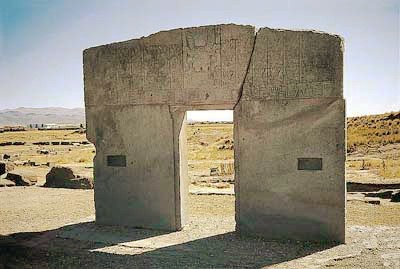
Hoy en día aún no está muy claro cuáles fueron los orígenes de esta cultura o de
dónde provenía, al igual de porqué y cuando desapareció. Se cree que la cultura
Tiwanaku tenía sus orígenes en la cultura Huari, una alta cultura peruana.
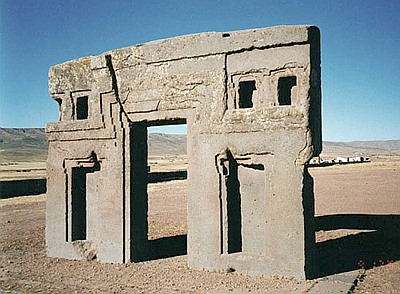
Los lugares de culto en el lago Titicaca, entre Perú y Bolivia fué en sus tiempos un
complejo de templos. Esto lo indican diversas ilustraciones de aparentes dioses.
Tanto el complejo como las piedras, están tratbajados con tal precisión que de ninguna
manera podría tratarse de un centro profano.
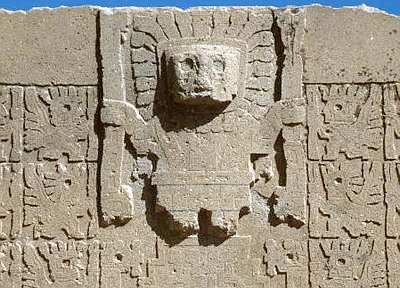
Pero lo más grandioso y al mismo tiempo ignorado por los turistas se encuentra
a unos 100 metros: Las ruinas de Puma Puncu. ?A quién van a interesar bloques de
piedra de hasta 1000 toneladas de peso?

Tanto el significado como la antigüedad del complejo son desconocidos.
Algunos arqueólogos atribuyen el complejo a los indios Aymara, pero ?como pudo ser que
un pueblo tan primitivo y sin ninguna ayuda técnica, moviera y trabajara estas
pesadas plataformas de hasta 1000 toneladas?
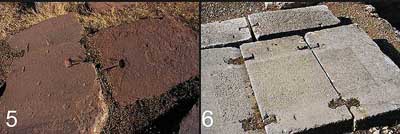
Los monolitos fueron unidos con grapas de metas (5). El mismo sistema de
estabilización de plataformas lo encontramos también en Delphi (6), pero los dos
complejos de templos se encuentran a miles de kilómetros de distancia.
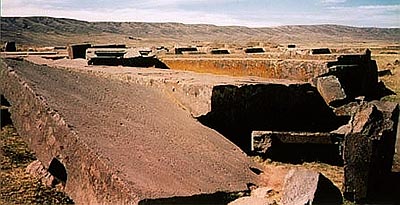
!La cantera de andesit y trachyt se encuentra a 17 kilómetros de distancia!
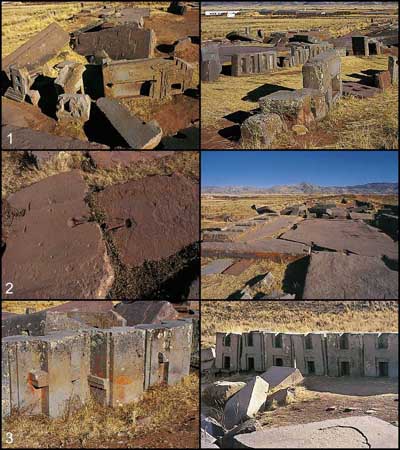
Grandes cantidades de bloques de piedra, como en una fábrica de hormigón
se encuentran dispersos por las ruinas.
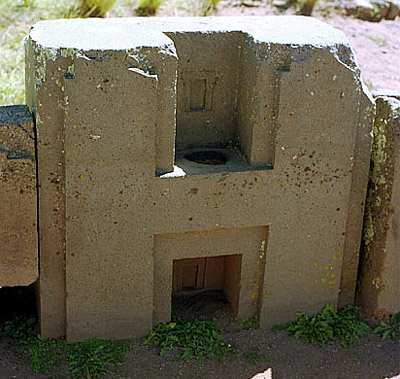
!Las distintas formas se acoplan unas a otras como un juego de construcción!
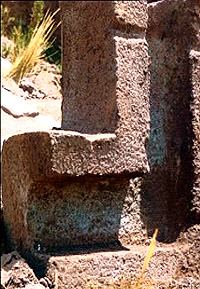 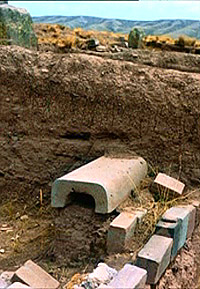
Si se observa las piezas de contrucción de hormigón, podría decirse que el
propósito de estas piedras era un sistema de canales o una protección
de cables subterráneos.
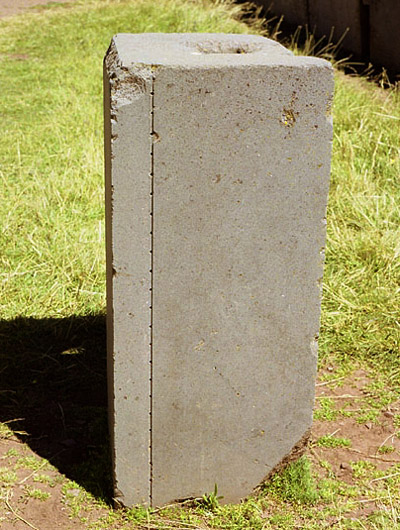
?Y qué explicación darán los arqueólogos cuando califiquen los trabajos
de tantísima precisión de los indios Aymara?
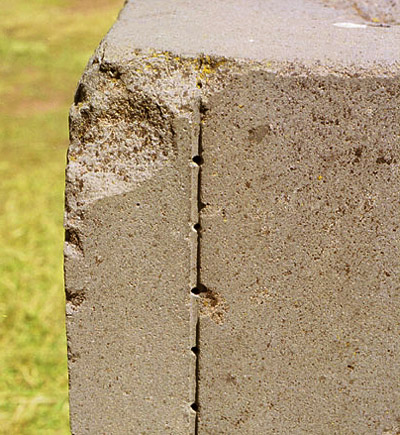
La pregunta, de qué manera y para qué fueron formados estos bloques,
sería quizás contestada por nuestros "especialistas" nada más que con
un ligero movimiento de hombros.
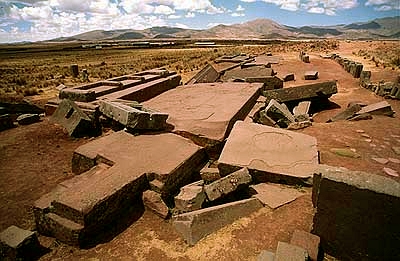
Y... una vez más nos dá una antiquísima leyenda una respuesta:
"Aquí vivían en sus entonces los dioses, y cuando abandonaron el
país destruyeron su "ciudad" en sólo una noche!
|
|
|
|
|
www.geschichteinchronologie.ch/.../03-04-Bolivia-Puma-Punku-cortes-p...
Literatura sobre Tiahuanaco - los "conductos de agua" -- Tubos, semitubos, tubos dobles, y formando codos rectos -- Faltan partes de los tubos - puede ser que ...
www.mundomisterioso.net/2011/.../antiguos-misterios-puma-punku-en.h...
25/04/2011 - Antiguos Misterios - Puma Punku en Tiahuanaco: Mundo misterioso.
arquehistoria.com/puma-punku-el-lugar-de-los-bloques-imposibles-15941
22/03/2013 - Puma Punku, el sitio o la puerta del puma. Puma Punku forma parte del monumental ancestral complejo de Tiahuanaco, en Bolivia.
El conjunto de Puma-punku se encuentra a 2 Km. del centro ceremonial descrito; en torno a estos dos puntos determinantes de la ciudad de Tiahuanaco se ...
Tiwanaku, ubicado en el altiplano boliviano, a 70 kilómetros de La Paz y a casi 4 mil .... La última parte del complejo se denomina Puma Punku y se encuentra a ...
huevodurosolar.es/videos-puma-punku-bloques-h-y-el-sol-h-blocks-and...
Ensamblaje de Bloques “H” de Puma Punku (Tiahuanaco) mediante la sombra y la ... La Horca del Inca en Bolivia como estructura precursora de Portales ...
Puma Punku ... opinion, the most significant piece of evidence that we have in this entire ancient alien astronaut puzzle is Pumapunku in the highland of Bolivia.
Puma Punku ruins, Tiahuanaco, Bolivia (courtesy of www.sacredsites.com and Martin Gray). The quarry for these giant blocks was on the western shore of ...
STRANGE STUFF PUMA PUNKU BOLIVIA 17000 YEARS OLD OLDEST TOWN IN THE WORLD. Back to STRANGE STUFF. Comments: X. << Last Next >>.
Anuncio relacionado con puma punku boliviaSe mostró este anuncio debido a tus términos de búsqueda actuales.
-
www.ask.com/Puma+Punku+Bolivia
Busca Puma Punku Bolivia Encuentra Resultados rápidos ahora!
|
|
|
|
|
|
Tiwanaku
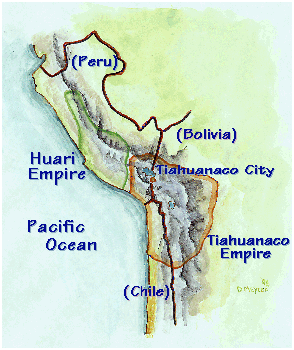
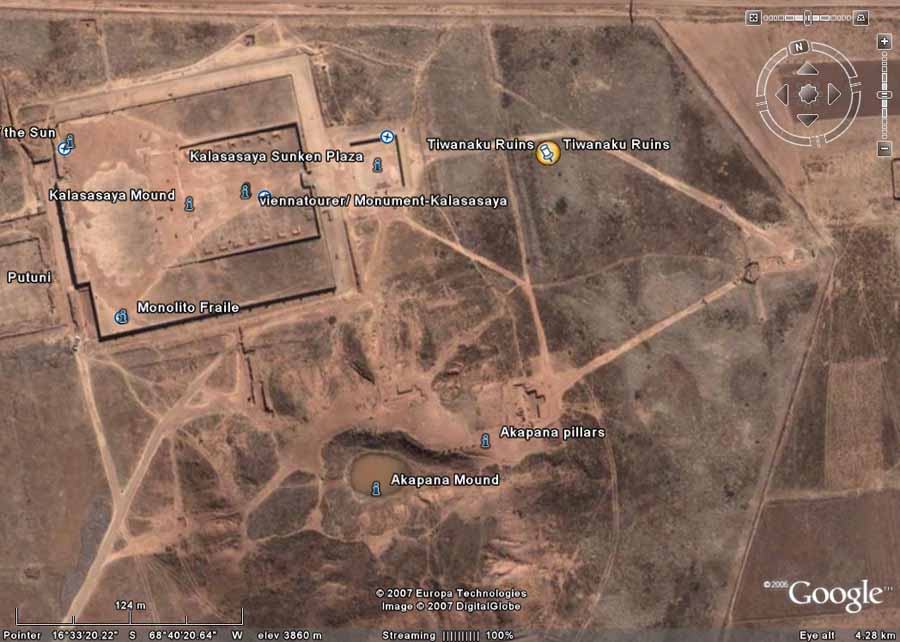
In the holograms of reality, and the myths within, Tiwanaku is another ancient civilization whose timeline came and went, leaving behind megalithic monuments that go without explanation as to their mathematical design and construction. Considered by some the oldest city in the world, much of Tiwanaku's creation defies the laws of physics and mathematics even by today's standards. Many monuments bear close resemblance to those created by other ancient cultures all over the planet, truly an overlap if one were to place hologram over hologram, to define the journey of humanity in time.
As with many other sacred sites throughout the planet Tiwanaku remains an enigma allowing researchers to speculate on its origins and purpose then parallel that with other ancient civilizations left behind by unknown beings surviving in time with great stone markers which bear clues to humanity's creation story. Gods, temples, idols, metaphors, all clues in a puzzle humanity is unraveling at this time of conscious awakening.
Tiwanaku was perhaps an ancient site where people came to worship their gods, or creators, giants who came here from the skies and in one day built Puma Punku (see below). Stone faces reveal the races of many and gray alien.
Background - Back Story
Tiwanaku is an important Pre-Columbian archaeological site in western Bolivia. It is recognized by Andean scholars as one of the most important precursors to the Inca Empire, flourishing as the ritual and administrative capital of a major state power for approximately five hundred years. The ruins of the ancient city state are near the south-eastern shore of Lake Titicaca in the La Paz Department, Ingavi Province, Tiwanaku Municipality, about 72 km (44 miles) west of La Paz.
The site was first recorded in written history by Spanish conquistador and self-acclaimed 'first chronicler of the Indies' Pedro Cieza de Leon. Leon stumbled upon the remains of Tiwanaku in 1549 while searching for the Inca capital Collasuyu. Some have hypothesized that Tiwanaku's modern name is related to the Aymara term taypiqala, meaning "stone in the center", alluding to the belief that it lay at the center of the world. However, the name by which Tiwanaku was known to its inhabitants has been lost, as the people of Tiwanaku had no written language.
Some believe Tiwanaku is the oldest city in the world. Others believe it was built by an extraterrestrial race who also created the Nazca Lines.
Cultural Development and Agriculture
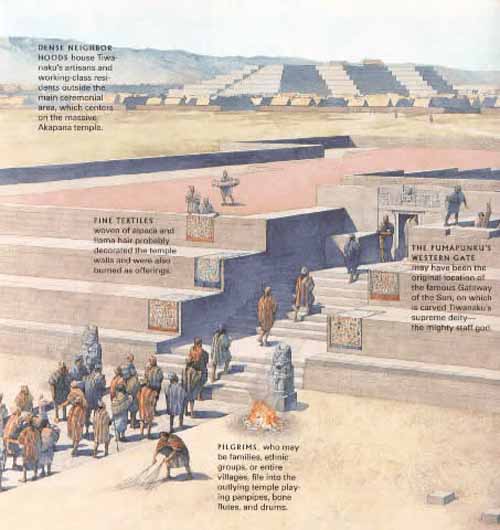
The area around Tiwanaku may have been inhabited as early as 1500 BC as a small agriculturally-based village. Most research, though, is based around the Tiwanaku IV and V periods between AD 300 and AD 1000, during which Tiwanaku grew significantly in power. During the time period between 300 BC and AD 300 Tiwanaku is thought to have been a moral and cosmological center to which many people made pilgrimages. The ideas of cosmological prestige are the precursors to Tiwanaku's powerful empire.
Tiwanaku's location between the lake and dry highlands provided key resources of fish, wild birds, plants, and herding grounds for camelidae, particularly llamas. The Titicaca Basin is the most productive environment in the area with predictable and abundant rainfall, which the Tiwanaku culture learned to harness and use in their farming. As one goes further east, the Altiplano is an area of very dry arid land.
The high altitude Titicaca Basin required the development of a distinctive farming technique known as "flooded-raised field" agriculture (suka kollus). They comprised a significant percentage of the agriculture in the region, along with irrigated fields, pasture, terraced fields and qochas (artificial ponds) farming.
Artificially raised planting mounds are separated by shallow canals filled with water. The canals supply moisture for growing crops, but they also absorb heat from solar radiation during the day. This heat is gradually emitted during the bitterly cold nights that often produce frost, endemic to the region, providing thermal insulation.
Traces of landscape management were also found in the Llanos de Moxos region (Amazonian food plains of the Moxos).
Over time, the canals also were used to farm edible fish, and the resulting canal sludge was dredged for fertilizer. The fields grew to cover nearly the entire surface of the lake and although they were not uniform in size or shape, all had the same primary function.
Though labor-intensive, suka kollus produce impressive yields. While traditional agriculture in the region typically yields 2.4 metric tons of potatoes per hectare, and modern agriculture (with artificial fertilizers and pesticides) yields about 14.5 metric tons per hectare, suka kollu agriculture yields an average of 21 tons per hectare.
Significantly, the experimental fields recreated in the 1980s by University of Chicago's Alan Kolata and Oswaldo Rivera suffered only a 10% decrease in production following a 1988 freeze that killed 70-90% of the rest of the region's production. This kind of protection against killing frosts in an agrarian civilization is an invaluable asset. For these reasons, the importance of suka kollus cannot be overstated.
As the population grew occupational niches were created where each member of the society knew how to do their job and relied on the elites of the empire to provide all of the commoners with all the resources that would fulfill their needs.
Little is known of the 30,000 to 60,000 urban dwellers or of the city's crafts or administrative functions. We also know little about the storage system that was required for the bounty of surplus foods from the agricultural fields, the vast llama herds on the Poona, and the abundant fish caught in the lake. The core of this imperial capital was surrounded by a moat that restricted access to the temples and areas frequented by royalty.
Some occupations include agriculturists, herders, pastoralists, etc. Along with this separation of occupations, there was also a hierarchal stratification within the empire.
The elite of Tiwanaku lived inside four walls that were surrounded by a moat. This moat, some believe, was to create the image of a sacred island. Inside the walls there were many images of human origin that only the elites were privileged to, despite the fact that images represent the beginning of all humans not only the elite. Commoners may have only ever entered this structure for ceremonial purposes since it was home to the holiest of shrines.
Rise and Fall of Tiwanaku
The city and its inhabitants left no written history, and modern local people know little about the city and its activities. An archaeologically based theory asserts that around AD 400, Tiwanaku went from being a locally dominant force to a predatory state. Tiwanaku expanded its reaches into the Yungas and brought its culture and way of life to many other cultures in Peru, Bolivia, and Chile. However, Tiwanaku was not exclusively a violent culture. In order to expand its reach, Tiwanaku used politics to create colonies, negotiate trade agreements (which made the other cultures rather dependent), and establish state cults.
Many others were drawn into the Tiwanaku empire due to religious beliefs as Tiwanaku never ceased being a religious center. Force was rarely necessary for the empire to expand, but on the northern end of the Basin resistance was present. There is evidence that bases of some statues were taken from other cultures and carried all the way back to the capital city of Tiwanaku where the stones were placed in a subordinate position to the Gods of the Tiwanaku in order to display the power Tiwanaku held over many.
Among the times that Tiwanaku expressed violence were dedications made on top of building known as the Akipana. Here people were disemboweled and torn apart shortly after death and laid out for all to see. It is speculated that this ritual was a form of dedication to the gods. Research showed that one man who was dedicated was not a native to the Titicaca Basin, leaving room to think that dedications were most likely not of people originally within the society.
The community grew to urban proportions between AD 600 and AD 800, becoming an important regional power in the southern Andes. According to early estimates, at its maximum extent, the city covered approximately 6.5 square kilometers, and had between 15,000 - 30,000 inhabitants.
However, satellite imaging was used recently to map the extent of fossilized suka kollus across the three primary valleys of Tiwanaku, arriving at population-carrying capacity estimates of anywhere between 285,000 and 1,482,000 people.
The empire continued to grow, absorbing cultures rather than eradicating them. William H. Isbell states that "Tiahuanaco underwent a dramatic transformation between AD 600 and 700 that established new monumental standards for civic architecture and greatly increased the resident population."
Archaeologists note a dramatic adoption of Tiwanaku ceramics in the cultures who became part of the Tiwanaku empire. Tiwanaku gained its power through the trade it implemented between all of the cities within its empire.
The elites gained their status by control of the surplus of food obtained from all regions and redistributed among all the people. Control of llama herds became very significant to Tiwanaku, as they were essential for carrying goods back and forth between the center and the periphery. The animals may also have symbolized the distance between the commoners and the elites.
The elites' power continued to grow along with the surplus of resources until about AD 950. At this time a dramatic shift in climate occurred. A significant drop in precipitation occurred in the Titicaca Basin, with some archaeologists venturing to suggest a great drought. As the rain became less and less many of the cities furthest away from Lake Titicaca began to produce fewer crops to give to the elites.
As the surplus of food dropped, the elites power began to fall. Due to the resiliency of the raised fields, the capital city became the last place of production, but in the end even the intelligent design of the fields was no match for the weather. Tiwanaku disappeared around AD 1000 because food production, the empire's source of power and authority, dried up. The land was not inhabited again for many years. In isolated places, some remnants of the Tiwanaku people, like the Uros, may have survived until today.
Beyond the northern frontier of the Tiwanaku state a new power started to emerge in the beginning of the 13th century, the Inca Empire.
In 1445 Pachacuti Inca Yupanqui (the ninth Inca) began conquest of the Titicaca regions. He incorporated and developed what was left from the Tiwanaku patterns of culture, and the Inca officials were superimposed upon the existing local officials. Quechua was made the official language and sun worship the official religion. So, the last traces of the Tiwanaku civilization were integrated or deleted.
|
|
|
|
|
Architecture
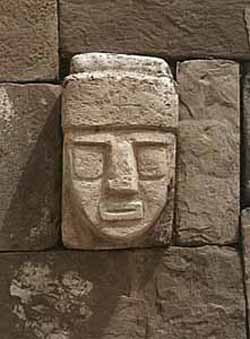
[Go to 53:27]
Tiwanaku monumental architecture is characterized by large stones of exceptional workmanship. In contrast to the masonry style of the later Inca, Tiwanaku stone architecture usually employs rectangular ashlar blocks laid in regular courses, and monumental structures were frequently fitted with elaborate drainage systems. The drainage systems of the Akapana and Puma Punku include conduits composed of red sandstone blocks held together by ternary (copper/arsenic/nickel) bronze architectural cramps. The I-shaped architectural cramps of the Akapana were created by cold hammering of ingots. In contrast, the cramps of the Akapana were created by pouring molten metal into I-shaped sockets.
The blocks have flat faces that do not need to be fitted upon placement because the grooves make it possible for the blocks to be shifted by ropes into place.
The main architectural appeal of the site comes from the carved images on the blocks along with carved doorways and giant stone monoliths. The stone used to build Tiwanaku was quarried and then transported 40 km or more to the city.
The most important edifice for dating purposes is the Kalasasaya ("Place of the Vertical Stones"). It is built like a stockade with 12 foot high columns jutting upward at intervals, each of these being carved into human figures.
The steps of the Kalasasaya (Temple), are each a
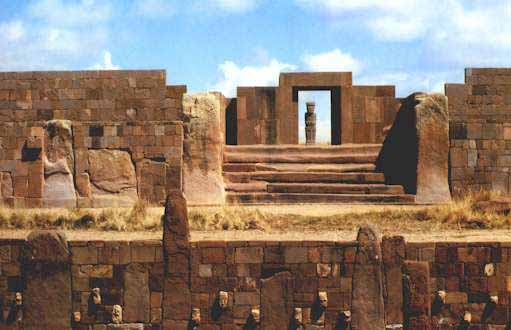
rectangular block of stone about 30 feet wide.
The megalithic entrance to the Kalasaya mound is here seen from the Sunken Courtyard viewing west. The Kalasaya stairway is a well-worn megalith, a single block of carved sandstone. Like the Kalasaya mound, the Sunken Courtyard is walled by standing stones and masonry infill. In this case the stones are smaller and sculptured heads are inset in the walls. Several stelae are placed in the center of the 30 m square courtyard.

The largest terraced step pyramid of the city, the Akapana, was once believed to be a modified hill, and has proven to be a massive human construction with a base 656 feet square and a height of 55.8 feet. It is aligned perfectly with the cardinal directions. Its base is formed of beautifully cut and joined facing stone blocks. Within the cut- stone retaining walls are six T- shaped terraces with vertical stone pillars, an architectural technique that is also used in most of the other Tiwanaku monuments. It originally had a covering of smooth Andesite stone, but 90% of that has disappeared due to weathering. The ruinous state of the pyramid is due to its being used as a stone quarry for later buildings at La Paz. Its interior is honeycombed with shafts in a complicated grid pattern, which incorporates a system of weirs used to direct water from a tank on top, going through a series of levels,and finally ending up in a stone canal surrounding the pyramid. On the summit of the Akapana there was a sunken court with an area 164 feet square serviced by a subterranean drainage system that remains unexplained.
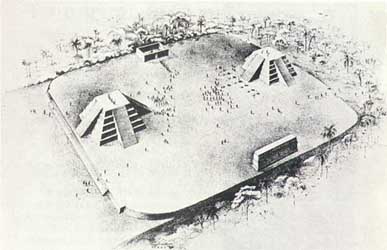
Associated with the Akapana are four temples: the Semi-subterranean, the Kalasasaya, the Putuni, and the Kheri Kala. The first of these, the Semi-subterranean Temple, was studded with sculptured stone heads set into cut-stone facing walls and in the middle of the court was located a now-famous monolithic stela. Named for archaeologist Wendell C. Bennett who conducted the first archaeological research at Tiwanaku in the 1930's, the Bennett Stela represents a human figure wearing elaborate clothes and a crown. The ancient Tiwanaku heartland is estimated to have been about 365,000, of whom 115,000 lived in the capital and satellite cities, with the remaining 250,000 engaged in farming, herding, and fishing.
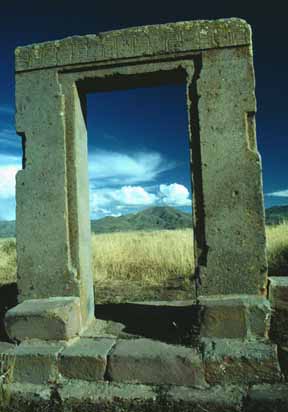
This megatlithic doorway is all that remains of the walls of a building on a small mound near the Kalasaya. Much of the readily accessible masonry at the ruin was used to construct the Catholic church in the village. A nearby railroad bridge also has Tiwanaku stone.
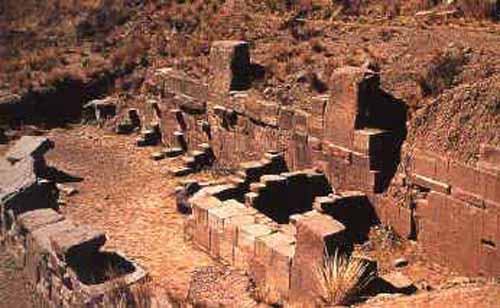
Adjacent to the sunken court, residences of the elite were revealed, while under the patio the remains of a number of seated individuals, believed to have been priests, faced a man with a ceramic vessel that displayed a puma-an animal sacred to the Tiwanaku. Ritual offerings of llamas and ceramics, as well as high-status goods made of copper, silver and obsidian were also encountered in this elite residential area. The cut-stone building foundations supported walls of adobe brick, which have been eroded away by the yearly torrential rains over the centuries.
In 1934 the Peruvianist Wendell C. Bennett carried out several excavations at Tiwanaku. Excavating in the Subterranean Temple he found two large stone images. One was a bearded statue. Depicted are large round eyes, a straight narrow nose and oval mouth. Rays of lightning are carved on the forehead. Strange animals are carved up around the head. It stands over 7 feet tall with arms crossed over an ankle- length tunic, which is decorated with pumas around the hem. Serpents ascend the figure on each side, reminding one of the Feathered Serpent culture-hero known as Quetzalcoatl in Central America.
Beside the bearded statue was a much larger statue Bennett's report as "the large monolithic statue" and is over 24 feet tall. It was sculpted out of red sandstone, and is covered with carved images of various kinds. He holds objects in each hand which are totally unidentifiable, although numerous interpretations have been suggested. The lower half of its body, which is covered with fish-scales (which upon close inspection are actually fish-heads). Immediately one recalls the Mesopotamian deity called Oannes, the man-fish amphibious being who conveyed special knowledge to ancient mankind. The statue has been removed from the site and now stands in a plaza in La Paz.
This monolithic piece of work has a number of designs scattered over its surface, many of which resemble the running winged-figures found on the Gate of the Sun, only with curled-up tails. The "Weeping God" is depicted on the sides of the head of the statue.
There are numerous other statues which have been found at Tiahuanacu, several of which have found their way into various museums. Most have the incomprehensible stiff designs scattered about on their surfaces in the typical Tiahuanacu style. Some are rather large, and others are small. Depictions of toxodons and several other extinct creatures are plentiful at Tiahuanacu. The images of these extinct animals are understandable on pottery and textiles, they could be copied by anyone from the stone monuments dotting the area.
In the northwest corner stands the Gateway of the Sun,
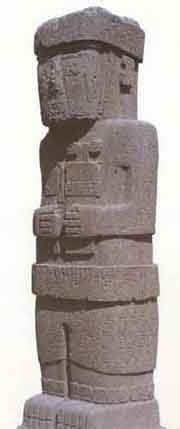
and in the southwest corner is The Idol.
This is one of two large anthropomorphic figures standings in the southwest corner of the Kalasasaya Temple. This one faces the entrance and is placed on the central axis. With the exception of the Sun Gate, it is the most picturesque of the sculptures at Tiahuanacu, since its 7-foot height is almost covered with hieroglyphic-like carvings. No one knows if these carvings represent a form of writing or are merely decorative. The figures resemble those on Easter Island.
The Akapana is the biggest platform on the site measuring 200 meters on each side and 17 meters tall and the largest ashlars of andesite or sandstone weigh over 100 tons.
Originally, the Akapana was thought to have been made from a modified hill, but recent studies have shown that most of the hill is man-made by taking dirt from the moat and packing it behind stone walls.
It is constructed from a mix of tall, upright, and small stones. There are staircases present on the east and west sides with a sunken court 50 meters long between them. Today the area where this would be is an indiscernible hole. The structure was possibly for the shaman-puma relationship or transformation. Tenon puma and human heads stud the upper terraces.
The Akapana East was built on the eastern side of early Tiwanaku and later became a boundary for the ceremonial center and the urban area. It was made of a thick prepared floor of sand and clay and supported a group of buildings. Yellow and red clay were used in different areas for what seems like aesthetic purposes. One major observation was that it was swept clean of all domestic refuse, signaling great importance to the culture.
The Kalasasaya is a large courtyard over three hundred feet long, outlined by a high gateway. It is located to the north of the Akapana and west of the Semi-Subterranean Temple. Within the courtyard is where explorers found the Gateway of the Sun, but it is contested today that this was not its original location.
Near the courtyard is the Semi-Subterranean Temple; a square sunken courtyard that's unique for its north-south rather than east-west axis. The walls are covered with tenon heads of many different styles postulating that it was probably reused for different purposes over time. It was built with walls of sandstone pillars and smaller blocks of Ashlar masonry. There are many more colossal stone statues, gateways and blocks including one that is 7.5 meters tall weighing well over 10 tons.
Within many of the sites structures are impressive gateways; the ones of monumental scale being placed on artificial mounds, platforms, or sunken courts. Many gateways show iconography of "Staffed Gods" that also spreads to some oversized vessels, indicating an importance to the culture. This iconography is most present on the The Gateway of the Sun.
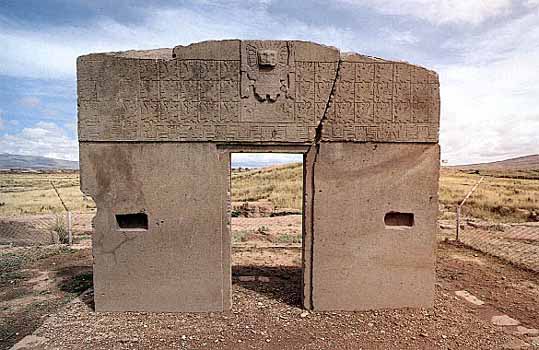
The Gate of the Sun
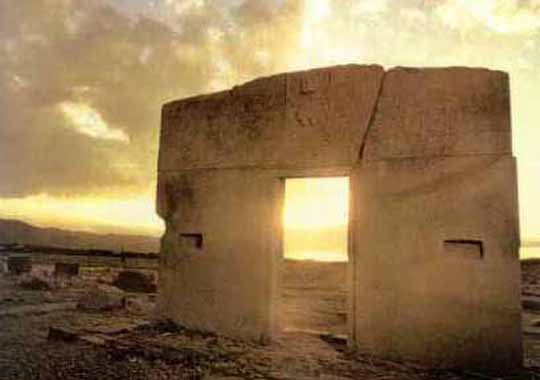
Winter Solstice
The Gate of the Sun is a stone gateway constructed by the Tiwanaku culture. It is located near Lake Titicaca at about 3,825 m above sea level in La Paz, Bolivia. The gate is approximately 9.8 ft (3.0 m) tall and 13 ft (4.0 m) wide. It was originally constructed by a single piece of stone. The weight is estimated to be 10 tons.
|
|
|
|
|
When the gate was originally found, it was lying face down and had a large crack. It stands in the place where it was found, although it is believed that this was not its original location. Gate of the Sun is a valuable monument to the history of art. Some elements of their iconography spread throughout Peru and parts of Bolivia; the engravings that decorate the gate has some astronomic connotations. There have been innumerable interpretations of the inscriptions on Gate of the Sun; many of them believe that it was used as a calendar.
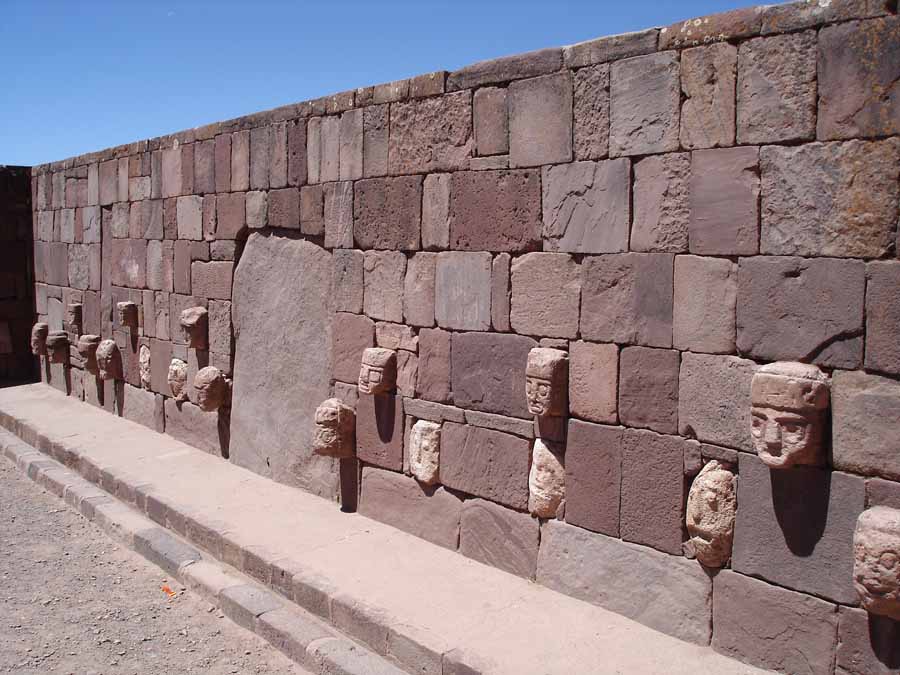
The lintel is carved with 48 winged effigies each in a square, 32 with human faces, and 16 with condor's heads. surrounding a central figure. These faces seem to represent many different races including a white face that looks like an alien gray.
All face the central figure (god). It is a figure of a man with the head surrounded by 24 stripes that represent rays shooting from his face. The styled staffs held by the figure symbolize thunder and lightning. Some historians believe that the central figure represents the Sun God by the rays of his head, while others identified it with the Inca god Viracocha.
This huge monument is hewn from a single block of stone, and some believe that the strange symbols might represent a calendar, the oldest in the world. A huge monolithic figure, facing east in the direction of sunrise, stands as silent witness to an unknown civilization established around 2200 years ago.
The Gateway of the Sun and others located at Puma Punku are all not complete, missing part of a typical recessed frame known as a chambranle and having sockets for clamps present for additions. These architectural examples, as well as the recently discovered Akapana Gate have a unique detail and skill in stone-cutting that reveal a knowledge of descriptive geometry. The regularity of elements suggest be part of a system of proportions.
Many theories for Tiwanaku's architecture construction have been proposed. One is that they used a luk'a which is a standard measurement of about sixty centimeters. Another argument is for the Pythagorean Ratio. This idea calls for right triangles at a ration of five to four to three used in the gateways to measure all parts. Lastly Protzen and Nair argue that Tiwanaku had a system set for individual elements dependent on context and composition. This is shown in the construction of similar gateways ranging from diminutive to monumental size proving that scaling factors did not affect proportion. With each added element, the individual pieces shifted to fit together.
Throughout their imperial reign, the Tiwanaku shared domination of the Middle Horizon with the Wari. Their culture rose and fell around the same time and was centered 500 miles north in the southern highlands of Peru. The relationship between the two empires is unknown either being cooperative or antagonistic. Definite interaction between the two is proved by their shared iconography in art. Significant elements of both of these styles, the split eye, trophy heads, and staff-bearing profile figures, for example, seem to have been derived from that of the earlier Pukara culture in the northern Titicaca Basin.
The Tiwanaku created a powerful ideology, using previous Andean icons that spread throughout their sphere of influence using extensive trade routes and shamanistic art. Tiwanaku art consisted of legible, outlined figures depicted in curvilinear style with a naturalistic manner, while Wari art used the same symbols in a more abstract, rectilinear style with a militaristic manner.
Art
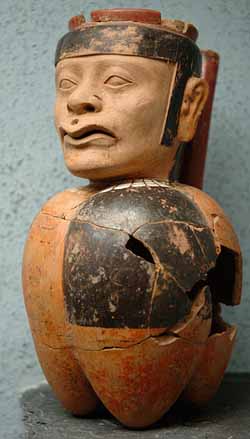
Tiwanaku sculpture is comprised typically of blocky column-like figures with huge, flat square eyes, and detailed with shallow relief carving. They are often holding ritual objects like the Ponce Stela or the Bennett Monolith. Some have been found holding severed heads such as the figure on the Akapana, possibly a puma-shaman. These images suggest ritual human beheading, which correlate with the discovery of headless skeletons found under the Akapana.
Ceramics and textiles were also present in their art, composed of bright colors and stepped patterns. An important ceramic artifact is the kero, a drinking cup, that was ritually smashed after ceremonies and placed in burials. However, as the empire expanded, ceramics changed in the society.
The earliest ceramics were "coarsely polished, deeply incised brownware and a burnished polychrome incised ware". Later the Qeya style became popular during the Tiwanaku III phase "Typified by vessels of a soft, light brown ceramic paste". These ceramics included libation bowls and bulbous bottom vases.
Examples of textiles are tapestries and tunics. The objects typically depicted herders, effigies, trophy heads, sacrificial victims, and felines. The key to spreading religion and influence from the main site to the satellite centers was through small portable objects that held ritual religious meaning. They were created in wood, engraved bone, and cloth and depicted puma and jaguar effigies, incense burners, carved wooden hallucinogenic snuff tablets, and human portrait vessels. Like the Moche, Tiwanaku portraits had individual characteristics in them.
Puma Punku
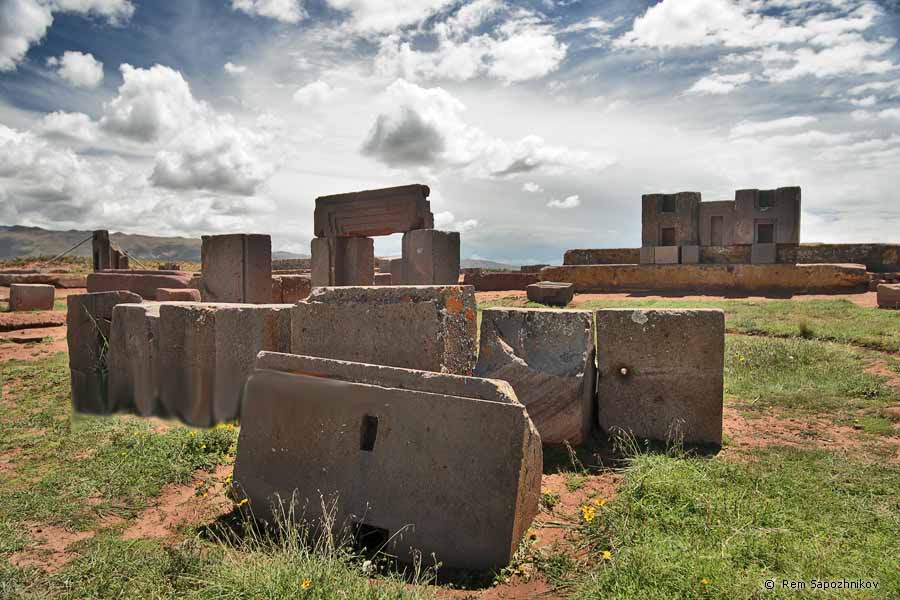
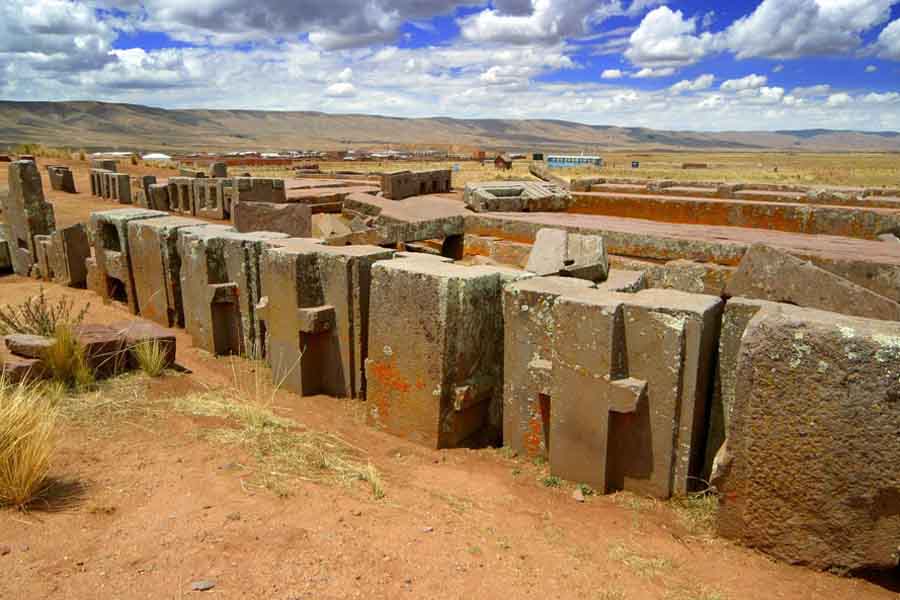
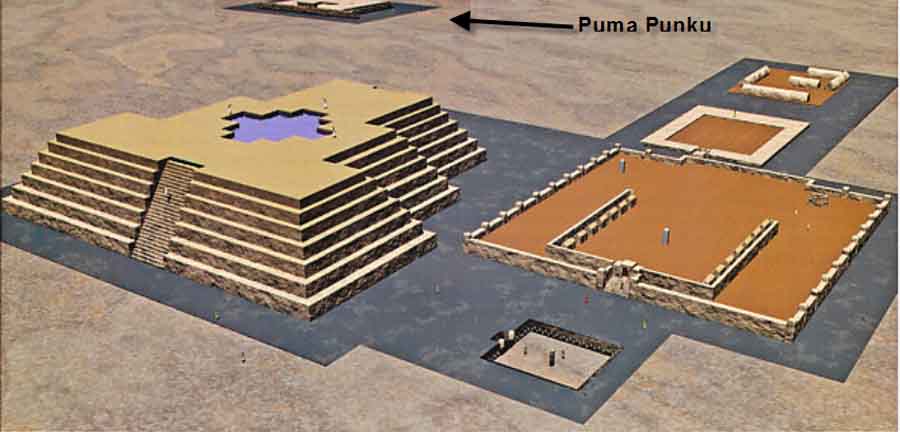
Puma Punku is a large temple complex located in Tiwanaku, Bolivia. In Aymara, the name Puma Punku means, "The Door of the Cougar". It is situated near the south eastern shore of Lake Titicaca, and sits on a plateau in the Andes at roughly 12,600 feet elevation.
Puma Punku's construction is generally argued to have taken place beginning around 200 BC. The temple itself stood at least 56 feet tall and took up an area of 164 square feet while the overall site and the surrounding constructions, namely the pyramid which the ruins sit on, extend over half a kilometer in length.
At its peak, Puma Punku is thought to have been unimaginably wondrous, adorned with polished metal plaques, brightly colored ceramic and fabric ornamentation, and trafficked by costumed citizens, elaborately dressed priests and elites decked in exotic jewelry.
Understanding of this complex is limited due to its age, the lack of a written record, and the current deteriorated state of the structures due to looting, stone mining for building stone and railroad ballast and natural weathering. The technological innovation and the beautiful stonework that went into the creation of Puma Punku have drawn comparisons to the Egyptian pyramids, Stonehenge and Easter Island.
Determining the age of these ruins has been a focus of researchers since the site's discovery. Currently archaeologists date the beginning of the Tiwanaku culture to some time around 1500 BC, and the construction of the Puma Punku complex to around 200 BC.
Previously, in the early 1900s, Bolivian engineer Arthur Posnansky, based on astronomical alignments, concluded that Tiwanaku was constructed as early as 15,000 BC (17,000 BP), possibly even older and was not an original construction of the Tiwanaku.
In the 1930s, German astronomers from the University of Bonn; Rolf Muller, Hanns Lundendorff, Friederich Becker, and Arnold Kohlshutter came to conclusions similar to Posnansky's estimate. However, as noted by Kolata subsequent archaeological research has found a complete lack of any physical evidence, including prehistoric tools and dated midden deposits, for any occupation of the Tiwanaku site as old as argued by Posnansky and the German astronomers either at the Tiwanaku Site, near it, or in direct association with the Puma Punku complex despite decades of intensive excavation and research.
The processes and technologies involved in the creation of these temples are still not fully understood by modern scholars. Our current ideas of the Tiwanaku culture hold that they had no writing system and also that the invention of the wheel was most likely unknown to them.
The architectural achievements seen at Puma Punku are striking in light of the presumed level of technological capability available during its construction. Due to the monumental proportions of the stones, the method by which they were transported to Puma Punku has been a topic of interest since the temple's discovery.
The stones are argued to have been transported up a steep incline from a quarry near Lake Titicaca roughly 20 miles away. Some of the blocks are said to weigh in the range of 100-130 tons.
One notable block has been measured at 36 feet long, 16 feet wide and 6 feet thick. Archaeologists argue that this was accomplished by the large labor force of ancient Tiwanaku. Several theories have been proposed as to how this labor force transported the stones although these theories remain speculative. Two of the more common proposals involve the use of llama skin ropes and the use of ramps and inclined planes.
In assembling the walls of Puma Punku, each stone was finely cut to interlock with the surrounding stones and the blocks fit together like a puzzle, forming load-bearing joints without the use of mortar. One common engineering technique involves cutting the top of the lower stone at a certain angle, and placing another stone on top of it which was cut at the same angle.
The precision with which these angles have been utilized to create flush joints is indicative of a highly sophisticated knowledge of stone-cutting and a thorough understanding of descriptive geometry.
Many of the joints are so precise that not even a razor blade will fit between the stones.
|
|
|
 Primer
Primer
 Anterior
2 a 16 de 46
Siguiente
Anterior
2 a 16 de 46
Siguiente Último
Último
|
|
| |
|
|
©2025 - Gabitos - Todos los derechos reservados | |
|
|
